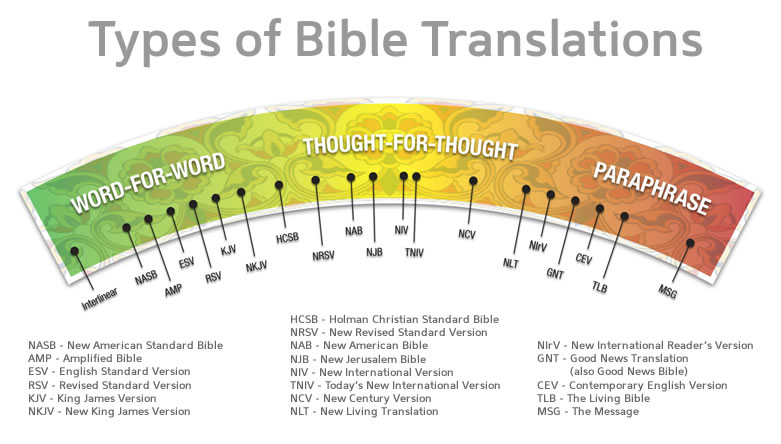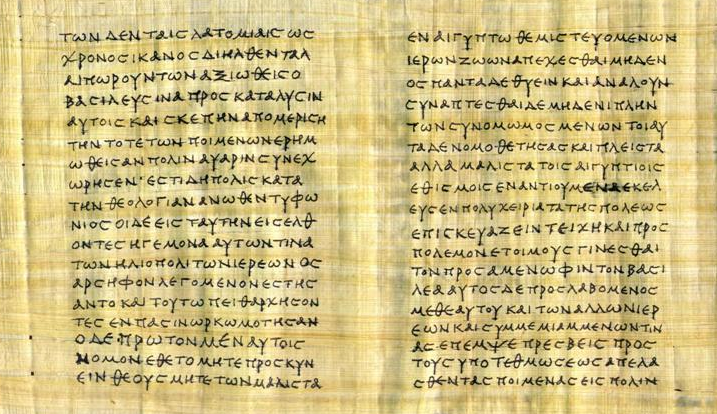Bible Translations
One of my friends sent me an email asking about Bible translations and requesting an introductory post on the subject. Well Ricardo, here you go…
Before we start talking about different translations, let’s begin by considering the language of the original Biblical manuscripts, which are known as “autographs”. In what language were these originals documents written? Despite what Henry Higgins suggests, the Bible was not originally written in English…

So, if it wasn’t English, in what language was the Bible initially written? Well, the original Biblical documents were, in fact, written in several languages. Different languages were used for the Old Testament and New Testament, so let’s look at them in turn…
The Old Testament: Hebrews do it backwards
The Old Testament was written mostly in Hebrew with some sections, such as parts of Ezra and Daniel, written in the closely-related language of Aramaic.

Old Testament Hebrew
Prior to the time of Jesus’ ministry, a Greek translation of the Old Testament known as the Septuagint (literally “seventy” or “LXX”) was widely used throughout the Roman Empire.
The New Testament: It’s all Greek to me
Koine Greek is assumed to have been the original language for all the New Testament, with the singular exception of Matthew’s Gospel which early Christian writers assert was originally written in Aramaic before being translated into Greek. Having said that, all the earliest manuscripts we possess are written in Greek, with only occasional words and phrases rendered in Aramaic, such as “talitha koum” and “Golgotha“.
Now that we’ve considered the original languages of the Bible, now let us turn to examine some factors which must be considered in translating these texts into the greatest language in the world, English…
Styles of translation
When translating a text from one language to another, there are two main approaches which can be taken in the conversion process:
1. Formal Equivalence
Examples of Bible translations which follow this strategy would be the King James Version (KJV), the Douai-Rheimes (DRA) and the American Standard Version (ASV). This method of translation aims at translating the document “word-for-word” from the original language into English as literally as possible. For example, in the Acts of the Apostles, the Douai-Rheims contains the following verse:
And they abode no small time with the disciples – Acts 14:27 (DRA)
This isn’t how we would say this today in English. We would say something like “And they stayed there a long time with the disciples”, which is how the New International Version (NIV) renders that verse. However, the Douai-Rheims is more faithful to the construction of the Greek:
διέτριβον – δὲ
they stayed – moreover
χρόνον – οὐκ – ὀλίγον
time – not – a little
σὺν – τοῖς – μαθηταῖς
with – the – disciples
As you can see, this style of conversion can sometimes lead to rather clunky and hard-to-understand translations. However, it has the advantage that it hides nothing from the reader and gets him as close to the original text as possible.
2. Dynamic Equivalence
The other method of translation aims at translating the document “throught-for-thought”. The translator translates the overall meaning of phrases and sentences, rather than just the meaning of individual words.
Many of the more modern translations favour this approach, such as the “New Jerusalem Bible” (NJB), “Good News Bible” (GNB) and “New Living Translation” (NLT). There are also other versions of the Bible which are not so much translations, but rather loose paraphrases, such as “The Message” and “The Living Bible”.
The advantage of this method is that the translation is usually smoother and easier to understand, but the disadvantage is that the translator has to make more decisions concerning the meaning of the text and is therefore making interpretive decisions on behalf of the reader.
Of course, not all Bible translations neatly fit within these two groups. Instead, it is more like graded spectrum:

Catholic and Protestant
While on the subject of Bible translations, it is worth mentioning that there are Catholic Bible translations and Protestant Bible translations. There are a couple of important differences between the two:
1. More Bible for your buck
Firstly, Protestant Bibles are lacking seven books known as the Deuterocanon which were taken out of the Bible at the Reformation. If you’re Catholic, you’re going to want these books!
2. Subtle bias
Secondly, although translators attempt to translate Scripture without bias, bias does inevitably seep into translations, especially when dynamic equivalence is used.
For a good example of this, one only has to look at the Protestant NIV translation and the Greek word “paradosis”. In general, when this word is used in the NIV in a positive and praise-worthy sense, it is translated as “teaching”, but when it’s used in a negative and condemning sense it is translated as “tradition”. In Protestant theology there is little emphasis on Sacred Tradition and I would suggest that this worldview influenced the translation of the word “paradosis” in the NIV. My friend Joe goes into more detail on this subject on his blog (Part 1 | Part 2).
For this reason, I would suggest that if you’re Catholic, you should use a Catholic Bible translation. The US Bishops’ Conference has an approved list of Catholic Bible translations to be found on their website.
Having said that, I will admit that I still have a soft spot for my NIV, having read it for several years during my ecclesiastical wanderings. These days I mostly use my Revised Standard Version, Second Catholic Edition (RSV-CE). That translation has a really good New Testament Study Bible and an excellent dramatized audio version is also available.
One translation I should probably mention is the “New American Bible” (NAB). If you go to Mass in a Roman-Rite parish here in the United States, the passages you will hear proclaimed from the Lectionary will be from this version. I’m not a fan of this translation, but at least I’m in good company and thankfully there’s a new revision of the NAB in the works.
Closing Thoughts & Year of Faith
I hope this post has been helpful and you are encouraged to dig deeper into Sacred Scripture. Since 2013 is the 40th anniversary of the Second Vatican Council, I would like to close with some words from the document on Divine Revelation:
“Easy access to Sacred Scripture should be provided for all the Christian faithful…since the word of God should be accessible at all times, the Church by her authority and with maternal concern sees to it that suitable and correct translations are made into different languages, especially from the original texts of the sacred books.
For in the sacred books…the force and power in the word of God is so great that it stands as the support and energy of the Church, the strength of faith for her sons, the food of the soul, the pure and everlasting source of spiritual life” – Second Vatican Council, Dei Verbum (Paragraphs 22 & 21)

Nick just posted an article showing a bias which may be found in the translation of the KJV.
You mean “thought-for-thought” not “through-for-thought”. Great article!
Good catch, thanks.